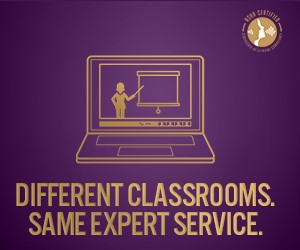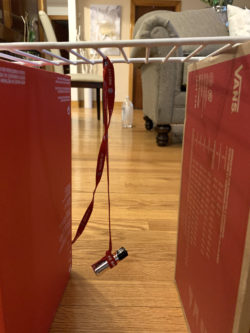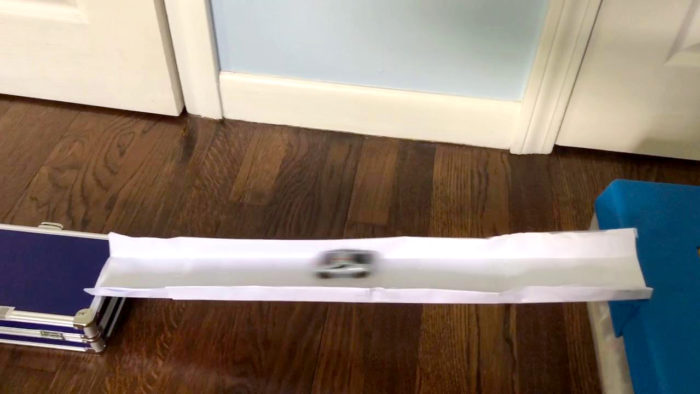Creativity in Crisis: Exploring science using everyday items and in the great outdoors
Superintendent of Georgetown Public Schools allowed educators to focus less on MCAS preparation during school closures, which led to bouts of creativity in the science department at Georgetown Middle/High School.
By: Steven Blackburn
In Massachusetts, students at Georgetown Middle/High School created and tested their own bridges that were made out of paper and tape.
Science instructors at a Massachusetts school system assigned activities that did more than require students to stare at their iPad screens during school closures. Students were encouraged to get out of the house and explore science outside in their backyards and neighborhoods. Meanwhile, others analyzed examples of science in the news or performed science experiments with household items.
“I used to teach current events every Friday as a science teacher, which I felt was time very well spent, but once the MCAS [Massachusetts Comprehensive Assessment System] standards landed, it became the overriding factor, and teachers had to make sure students were prepared for that exam,” says Cerise Cauthron, science department chair of Georgetown Middle/High School in Georgetown Public Schools. “The lockdown lifted an enormous weight off our shoulders in a strange way by allowing us to go back to what we were doing before these state standards and offer tailor-made activities for our students. It has been phenomenally freeing in many ways.”
Going easy on the MCAS
When the governor of Massachusetts closed schools for the rest of the year, the state provided standards for every core subject and wanted teachers to help students with MCAS preparations for that year or in 2021 if the assessments were canceled. But the district’s superintendent later allowed teachers to scale back if needed.

“She said to try to get half of what we would have gotten done under normal circumstances and to be creative in our approach,” says Cauthron. “My advice was to pursue bundling, so if there were a certain concept that teachers had to hit, we could tie in prior learning or introduce topics that we would have taught later.”
Exploring science outside
An environmental science instructor followed her superintendent’s advice by encouraging students to visit a creek down by the school to collect data or to venture into their backyards and neighborhoods. “She told students to dig dirt out of the ground, and identify what type of soil they have, what type of growth it supports and what would grow if they didn’t cut their lawns every day,” says Cauthron.
Meanwhile, students with highly manicured lawns were asked to find areas in their neighborhood with overgrowth for comparison and vice versa.
This teacher and other educators communicated these and other activities during hour-long Zoom sessions twice per week.
Dissecting science in the news
The freedom of not having to focus on the MCAS allowed teachers to connect current events with science principles. Students explored the topic of COVID-19 by discussing the general concept of vaccines and the Anti-Vax movement.
Educators also encouraged students to watch the SpaceX launch on June 3 live or to find clips on YouTube. “We asked what was different about this launch to previous launches, if they thought it was a success and if we should look at privatizing the space industry,” says Cauthron.
Read other articles that are part of our Creativity in Crisis series:
How to teach hands-on engineering remotely
Delivering ed-tech PD with ‘Tech Tidbits’
Dressing up as various characters to engage students
WiFi buses narrow the digital divide
How to hold a virtual wellness week
“In general, we asked students to keep an eye out on the news and to find a story that sparked their interest,” she adds. “You see a lot of these types of questions and activities in in history classes, but in science, it is just as important.”
Science experiments with household items

In Massachusetts, students at Georgetown Middle/High School created their own pendulums using everyday objects during school closures.
By teaching in a 1 to 1 district, Cauthron and many of her peers could have students download free video analysis apps to analyze data and perform their own experiments.
But for instructors whose courses required hands-on learning, educators had students create science experiments with household items by making and testing bridges using only paper and tape, for example. “Our teachers provided students with criteria on what construction material criteria could find at home and had students film as they tested their bridges while saying what was working and how they could improve the structure of their bridges by just using paper and tape,” says Cauthron.
In one of her classes, students created pendulums out of everyday objects at home and analyzed the friction and amplitude, in addition to other science theories.
She adds, “This phenomenon has allowed us to do what we did in the old days to help students become better citizens and to provide creativity for our kids.”
Author: Steven Blackburn
